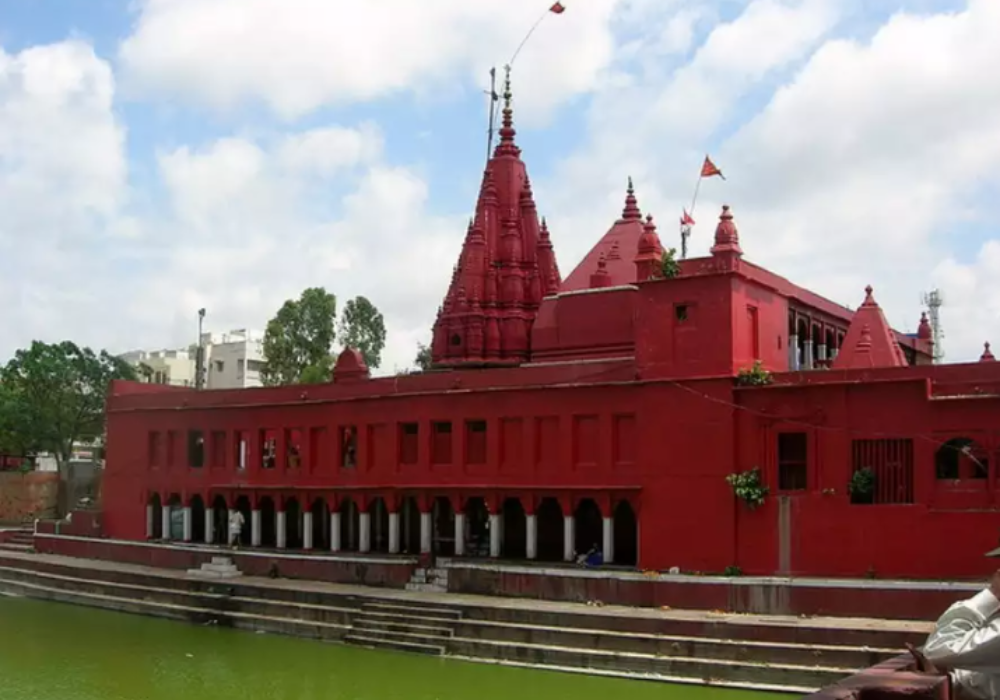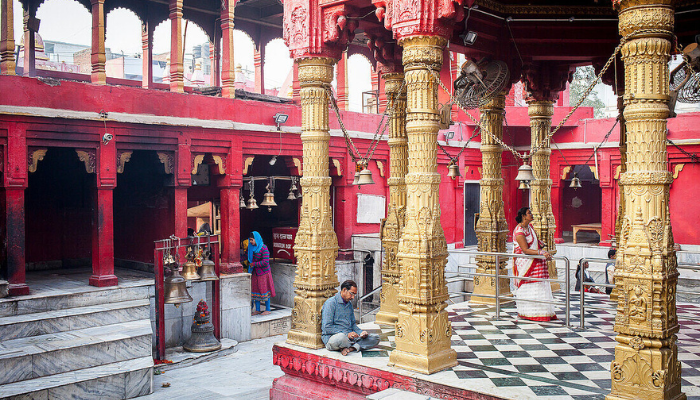
Varanasi, a city steeped in ancient traditions and spiritual fervor, offers countless sacred sites for pilgrims and curious travelers alike. Among these revered destinations, the Durga Temple Varanasi stands out as a beacon of divine energy and architectural beauty. This prominent Hindu temple, dedicated to Goddess Durga, embodies the very essence of protection and power in the spiritual heartland of India. It is often referred to as the “Monkey Temple” due to the lively presence of monkeys within its vicinity. Moreover, the adjacent sacred pond, known as Durga Kund Temple Varanasi, adds another layer of mystique and ritual to this profound site. Visiting this temple is a journey into the rich tapestry of Hindu mythology, ancient architecture, and vibrant local customs.
History and Significance of Durga Temple Varanasi
The Durga Temple Varanasi possesses a history that dates back to the 18th century. It was built by Rani Bhabani, the queen of Natore in Bengal, a devout worshipper of Goddess Durga. This construction effort aimed to honor the goddess and strengthen cultural connections between Bengal and Kashi. Furthermore, the temple is a fine example of the North Indian Nagara style of architecture, showcasing intricate carvings and a multi-tiered spire. Legends associated with the temple suggest that the idol of Goddess Durga inside the sanctum is “Swayambhu,” meaning it miraculously appeared on its own, not sculpted by human hands. This belief significantly enhances the temple’s spiritual sanctity.
The Legend of the Red Temple
The striking red color of the Durga Temple Varanasi holds deep symbolic meaning. Achieved by using ochre, this vibrant hue represents the fierce energy of Goddess Durga herself. Red signifies power, fertility, and auspiciousness in Hindu tradition. According to local folklore, the temple was constructed at the very spot where Goddess Durga triumphed over the formidable demon Mahishasura. This mythological connection deeply enriches the temple’s spiritual and cultural importance. Another legend, found in chapter 23 of the Devi-Bhagavata Purana, narrates how Goddess Durga appeared on a lion to protect Prince Sudarshan and the king of Varanasi, Kashi Naresh, during a war. After this divine intervention, Kashi Naresh pleaded with Durga to safeguard Varanasi, leading to the temple’s construction. This narrative firmly establishes the temple as a place of divine protection.
Architectural Marvels and Nagara Influence
The architecture of the Durga Temple Varanasi is a splendid illustration of the Nagara style. This style is characterized by its towering spire, known as a shikhara, which often features a curvilinear shape and intricate carvings. The temple’s shikhara rises majestically, adorned with smaller shikharas and kalashas, showcasing the rich heritage of Indian temple architecture. The walls and ceilings of the temple are intricately carved with scenes from Hindu mythology, reflecting the artistic brilliance of the 18th century. Moreover, the temple’s square shape, built with red stone, further emphasizes its association with the powerful Mother Durga. The design beautifully combines spirituality with artistry, making it an architectural gem in Varanasi.
Exploring the Durga Kund: A Sacred Pond

Adjacent to the Durga Temple Varanasi lies a rectangular pond known as Durga Kund Temple Varanasi. The word “kund” in Hindi translates to “pond” or “pool,” highlighting this significant water body. Historically, this kund was connected to the Ganges River, allowing it to naturally replenish with river water. However, due to urban infrastructure changes, the connection has been severed, and the pond now relies on rainwater and temple drainage for replenishment. Despite this, the kund retains immense symbolic and functional importance within the temple complex.
Rituals and Beliefs at Durga Kund
The Durga Kund Temple Varanasi plays a crucial role in various ceremonial purposes and religious rituals. Devotees often take a ritual bath in the Durga Kund before entering the main temple, believing it purifies them. The kund is especially significant during festivals like Nag Panchami, a Hindu festival dedicated to serpent deities. On this day, a symbolic depiction of Lord Vishnu reclining on the serpent Shesha Nag is displayed in the waters, attracting many devotees who believe it brings good fortune and protection from evil. Furthermore, some local beliefs suggest that the water in this pool originates from Patal (the underworld) and thus never dries up, symbolizing the eternal power of the divine mother. This unique aspect makes the kund a focal point for spiritual solace and connection.
Visiting Durga Temple Varanasi: Timings and Best Practices
For those planning a spiritual journey to this ancient city, understanding the Durga Temple Varanasi timings is essential. The temple welcomes devotees seven days a week. Generally, the temple opens early in the morning, around 4:00 AM in summer and 5:00 AM in winter, and darshan continues until 1:00 PM. After a break, it reopens in the afternoon from 3:00 PM to 9:00 PM. However, specific timings for aartis are observed daily.
Daily Darshan and Aarti Schedule
The daily aarti schedule at Durga Temple Varanasi creates a deeply spiritual atmosphere, drawing many devotees. The Mangala Aarti is performed early in the morning at 4:00 AM. Following this, the Bhog Aarti takes place at 12:00 PM. In the evening, the Sandhya Aarti is conducted at 7:00 PM, and finally, the Sayan Aarti marks the temple’s closing at 10:00 PM. Visiting during these aarti times allows visitors to immerse themselves in the temple’s divine aura, with the sounds of bells and chants filling the air. It is a truly uplifting experience.
Important Festivals and Special Occasions
The Durga Temple Varanasi becomes exceptionally vibrant during major Hindu festivals. Navaratri is one of the most significant celebrations, dedicated to worshipping Goddess Durga. During this nine-day festival, the temple is adorned with colorful decorations, and special rituals, prayers, and cultural events are organized to celebrate the triumph of Goddess Durga over evil. Thousands of devotees flock to the temple during Navaratri, seeking blessings for protection, prosperity, and strength. Another important occasion is Durga Puja, when the idol of Goddess Durga is immersed in the Ganges River. These festivals offer a unique opportunity to witness the profound devotion and rich cultural heritage of Varanasi.
The Spiritual Ambiance and Devotee Experience

Stepping into the Durga Temple Varanasi offers a profound spiritual experience. The atmosphere is charged with devotion, as pilgrims and tourists alike seek blessings and solace. The continuous chanting of hymns and the aroma of incense create a serene environment. Many devotees believe that visiting this temple can remove obstacles and grant strength and protection. The temple is particularly significant for women, who visit to seek blessings for family welfare and marital harmony.
The Power of Chanting and Offerings
Inside the temple, devotees engage in various forms of worship, including offering flowers, sweets, and incense to the deity. The act of circumambulating the temple, known as pradakshina, is also a common practice, believed to have religious significance. The presence of numerous monkeys, which have earned the temple its nickname, adds to the unique experience. These lively creatures are often seen around the premises. The fervent devotion of the worshippers and the spiritual energy of the place make every visit memorable.
Connecting with the Divine Energy
The Durga Temple Varanasi serves as a powerful center for connecting with the divine feminine energy, or Shakti. Goddess Durga, as the embodiment of power, protection, and motherhood, is revered here in her fierce yet protective form. Devotees feel a deep sense of peace and liberation as they offer prayers and immerse themselves in the temple’s divine aura. The belief that the goddess herself manifested here adds to the profound spiritual charge of the site. This connection to the divine is a cornerstone of the spiritual journey in Varanasi.
Nearby Attractions and Exploring Varanasi
The Durga Temple Varanasi is located in a vibrant area of the city, close to several other significant religious and cultural landmarks. Visitors can easily explore these nearby attractions, enriching their overall experience of Varanasi. This proximity allows for a comprehensive spiritual and cultural tour. Consequently, many travelers include these sites in their itinerary.
Sankat Mochan Hanuman Temple
Just a short distance from the Durga Temple Varanasi is the famous Sankat Mochan Hanuman Temple. This revered temple is dedicated to Lord Hanuman, the monkey god, who is worshipped as the “reliever from troubles.” Poet-saint Tulsidas established this temple in the early 16th century, on the tranquil banks of the Assi River. It is believed that Tulsidas had a divine vision of Hanuman at this very spot. Thousands of devotees, especially on Tuesdays and Saturdays, visit to offer prayers and seek blessings for strength and protection. The temple also plays a role in astrological remedies, with many believing that visiting helps mitigate the ill effects of the planet Shani (Saturn). This temple is a peaceful retreat and a symbol of unwavering faith.
Tulsi Manas Temple
Another important temple located very close to the Durga Temple Varanasi is the Tulsi Manas Temple. This temple holds immense historical and cultural significance as it is believed to be the spot where the revered saint and poet Goswami Tulsidas composed the epic Ramcharitmanas in the 16th century. Crafted from white marble, the temple radiates a serene glow and features intricate images of Lord Rama, Mother Sita, Lakshman, and Lord Hanuman carved into its walls. The temple’s Shikhara-style architecture is adorned with inscriptions from the Ramcharitmanas, making it a unique sight. It also houses a museum with a rare collection of manuscripts and artifacts. The beautiful landscaping around the temple further enhances its charm.
Assi Ghat and its Vibrancy
The Durga Temple Varanasi is also conveniently located near Assi Ghat, one of the most popular and southernmost ghats in Varanasi. This ghat is a vibrant hub of activity, where the holy Ganga River meets the mythological Assi River. Visitors can witness the famous Subah-e-Banaras, a morning event that includes yoga, classical music, and meditation, celebrating the spiritual essence of Varanasi. The evening Ganga Aarti at Assi Ghat is another mesmerizing experience, with priests performing rituals with oil lamps, chants, and music. Boat rides from Assi Ghat offer stunning views of the other ghats along the Ganges, especially during sunrise and sunset. Assi Ghat is a perfect place to soak in the spiritual and cultural vibrancy of Varanasi.
Cultural Significance and Local Life Around Durga Temple
The Durga Temple Varanasi is not merely a religious site; it is an integral part of the city’s cultural fabric. Its presence deeply influences the daily lives of local residents and contributes significantly to Varanasi’s unique spiritual identity. Consequently, the area around the temple bustles with traditional activities. Furthermore, it offers a glimpse into the authentic local lifestyle.
Varanasi’s Spiritual Tapestry
Varanasi, often called the spiritual capital of India, is a city where ancient traditions seamlessly blend with modern life. The Durga Temple Varanasi plays a vital role in this spiritual tapestry, attracting devotees who seek blessings and a connection to the divine. The temple is a focal point for women-centric rituals and fosters cultural bonding among Bengali and local communities. This deep integration makes the temple a living monument of faith. Additionally, it highlights the enduring spiritual practices of the region.
Local Artisans and Souvenirs
The lanes surrounding the Durga Temple Varanasi are often filled with shops selling religious artifacts, offerings, and local handicrafts. Visitors can find a variety of items, including idols of deities, prayer beads, traditional clothing, and souvenirs. Purchasing these items supports local artisans and provides a tangible memory of the spiritual journey. The vibrant markets offer a sensory experience, with the sounds of temple bells, devotional music, and the aroma of incense mixing with the chatter of vendors and devotees. This lively atmosphere truly captures the essence of Varanasi. Therefore, exploring these areas is highly recommended for an immersive experience.
Planning Your Pilgrimage: Tips for Visitors
A visit to the Durga Temple Varanasi can be a deeply rewarding experience. However, a little planning helps ensure a smooth and respectful pilgrimage. Considering these practical tips will enhance your spiritual journey. Therefore, it is wise to prepare in advance.
Dress Code and Etiquette
When visiting temples in Varanasi, including the Durga Temple Varanasi, it is always advisable to dress modestly. While there isn’t a strict universal dress code for all temples in Varanasi, generally, conservative attire is recommended. This means avoiding short or revealing clothes. For women, sarees or salwar suits are appropriate, and for men, dhoti-kurta or full-length pants are suitable. Some temples, like the Kashi Vishwanath Temple, have specific rules, especially for touching the idol, where traditional attire like dhoti-kurta for men and sarees for women is required. Although the Durga Temple might not have such stringent rules for general darshan, dressing respectfully shows reverence for the sacred space. Additionally, it’s customary to remove your shoes before entering the temple premises. Always be mindful of your surroundings and the local customs.
Navigating the Lanes of Varanasi
Varanasi’s narrow, winding lanes can be challenging to navigate, especially for first-time visitors. However, exploring these alleys is part of the city’s charm. The Durga Temple Varanasi is accessible by various local transport options. You can take an auto-rickshaw or a cycle rickshaw from different parts of Varanasi. The temple is approximately 13 km from Varanasi Cantt railway station. Hiring a private taxi or cab can also be a convenient option for comfortable travel. Walking is often the best way to explore the immediate vicinity of the temple and soak in the local atmosphere. Be prepared for crowds, especially during festivals. It is advisable to carry minimal belongings and keep them secure.
Accommodation Options Near the Temple
For visitors wishing to stay close to the Durga Temple Varanasi, there are numerous accommodation options available, catering to various budgets and preferences. You can find everything from budget-friendly guesthouses to luxury hotels in the vicinity. Some popular choices include Ganpati Guest House, Bhadra Kali Guest House, and Marigold Guest House. Other well-rated hotels and hostels in the area include Hotel Rivera Palace, Moustache Hostel Varanasi, and Live Free Hostel Varanasi. Many hotels offer amenities like free breakfast and comfortable rooms. Booking your stay in advance, especially during peak season or festivals, is highly recommended to secure your preferred accommodation.
FAQs about Durga Temple Varanasi
Q1: What is the primary significance of Durga Temple Varanasi?
The Durga Temple Varanasi is primarily dedicated to Goddess Durga, a powerful Hindu deity representing divine power, protection, and motherhood. It is believed to be a sacred site where devotees seek blessings for strength, protection, and the fulfillment of wishes.
Q2: Why is Durga Temple Varanasi sometimes called the “Monkey Temple”?
The Durga Temple Varanasi is popularly known as the “Monkey Temple” due to the significant population of monkeys living in and around the temple premises. These monkeys are a common sight for visitors.
Q3: What are the general Durga Temple Varanasi timings for visitors?
The Durga Temple Varanasi is open daily. Generally, it opens around 4:00 AM (summer) or 5:00 AM (winter) for morning darshan, closing at 1:00 PM. It reopens from 3:00 PM to 9:00 PM for evening darshan. Specific aarti timings include Mangala Aarti at 4:00 AM, Bhog Aarti at 12:00 PM, Sandhya Aarti at 7:00 PM, and Sayan Aarti at 10:00 PM.
Q4: What is the history behind the construction of Durga Temple Varanasi?
The Durga Temple Varanasi was constructed in the 18th century by Rani Bhabani, the queen of Natore in Bengal. Legends suggest the idol of Goddess Durga within the temple is self-manifested, adding to its ancient and sacred origins.
Q5: Is there a specific dress code for visiting Durga Temple Varanasi?
While the Durga Temple Varanasi does not have a strictly enforced dress code like some other temples, it is highly recommended to dress modestly out of respect for the sacred space. Conservative attire, such as sarees or salwar suits for women and dhoti-kurta or full-length pants for men, is appropriate. Removing shoes before entering is customary.
Q6: What is the significance of the Durga Kund Temple Varanasi?
The Durga Kund Temple Varanasi refers to the sacred rectangular pond adjacent to the Durga Temple. It is believed to have spiritual significance, with devotees often taking ritual baths before entering the temple. The kund is especially important during festivals like Nag Panchami, when special rituals are performed.
Q7: What major festivals are celebrated at Durga Temple Varanasi?
The most significant festival celebrated at the Durga Temple Varanasi is Navaratri, a nine-day festival dedicated to Goddess Durga. During this time, the temple is vibrantly decorated, and special prayers and rituals are conducted. Durga Puja is another important celebration.
Q8: Are there any other deities worshipped inside Durga Temple Varanasi?
Yes, in addition to Goddess Durga, the temple premises also house idols of other revered deities such as Goddesses Lakshmi, Saraswati, and Kali, as well as Lord Shiva, Lord Ganesha, and Lord Hanuman. This makes it a comprehensive site for Hindu worship.
Q9: How can one reach Durga Temple Varanasi?
The Durga Temple Varanasi is easily accessible within Varanasi. Visitors can reach it by auto-rickshaw, cycle rickshaw, or private taxi/cab from various parts of the city, including Varanasi Cantt railway station and Lal Bahadur Shastri International Airport (VNS). It is located near the Durga Kund area.
Q10: What makes the architecture of Durga Temple Varanasi unique?
The Durga Temple Varanasi showcases the distinctive North Indian Nagara style of architecture. Its unique features include a towering, multi-tiered shikhara (spire) adorned with intricate carvings. The temple’s striking red color, achieved with ochre, is also a symbolic and unique architectural highlight, representing the goddess’s powerful energy.

Binu Lamba
Binu Lamba is a 29-year-old editor and fact-checker with 7 years of experience in travel content. He verifies all location details, hotel recommendations, and travel tips to ensure our guides are accurate, updated, and helpful for readers planning real trips.

AI Assistant
Our AI writing assistant supports the creation of travel content under strict human supervision. All AI-generated posts are thoroughly reviewed, fact-checked, and updated by our team to maintain trust and accuracy in our travel recommendations.

The Ultimate Guide: Finding the Best Way to Reach Shimla in 2025
Are you planning a trip to the ‘Queen of Hills’? Are you puzzled about the best way to reach Shimla? You are not alone. This

Discover the Best Hotels in Mumbai for an Unforgettable Stay
Finding the best hotels in Mumbai is easy once you know where to look. Whether you’re visiting for business, leisure, or a mix of both,

Best Hotels in Udaipur: Your Ultimate Guide for a Comfortable Stay
Udaipur is known for its palaces, lakes, and rich culture, and staying at the best hotels in Udaipur can make your visit even more memorable.








